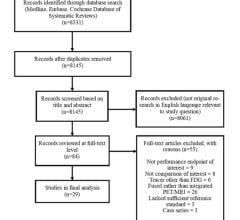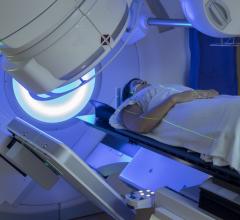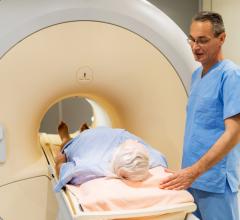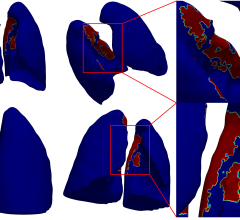January 14, 2015 — Locally advanced rectal cancer patients who receive preoperative radiation therapy with either irinotecan plus capecitabine or oxaliplatin plus capecitabine have a four-year overall survival rate of 85 percent and 75 percent, respectively, according to a study published in the International Journal of Radiation Oncology • Biology • Physics (Red Journal), the official scientific journal of the American Society for Radiation Oncology (ASTRO).
RTOG 0247 was a randomized, Phase II multicenter trial of patients with locally advanced (T3 and T4) rectal cancer treated with neoadjuvant chemoradiation from March 2004 to February 2007.
The primary endpoint analysis of RTOG 0247 examined the pathologic complete remission (pCR) rates of two concurrent neoadjuvant chemotherapy regimens to determine which regimen should be studied further. The initial results demonstrated that patients who received irinotecan plus capecitabine had lower pCR rates (10 percent compared to those who received oxaliplatin plus capecitabine (21 percent).
The study accrued 146 patients from 59 institutions. All patients received preoperative pelvic radiation therapy of 50.4 Gy over five and a half weeks, with 45 Gy delivered in 25 fractions (1.8 Gy per fraction, five fractions per week for five weeks) and a boost of 5.4 Gy in three fractions. Patients were randomized to two chemotherapy treatment arms concurrent to their radiation therapy.
Patients in arm 1 received concurrent chemotherapy consisting of four doses of irinotecan (50 mg/m2 IV weekly) and capecitabine (1200 mg/m2/d orally Mon. through Fri. during radiation therapy). Patients in arm 2 received concurrent chemotherapy consisting of five doses of oxaliplatin (50 mg/m2 IV weekly) and capecitabine (1600 mg/m2/d orally Mon. through Fri. during radiation therapy).
All patients in each arm had surgery four to six weeks after completion of radiation therapy, and all patients in both arms had postoperative chemotherapy of FOLFOX (Oxaliplatin, leucovorin; 5-fluorouacil (5-FU); and 5-FU infusion) four to six weeks after surgery. Both arms of the study were temporarily closed in January 2005 due to excessive gastrointestinal adverse events. The study reopened in April 2005 with an amended chemotherapy regimen. One hundred four patients, 52 in each arm, were eligible and included in this analysis.
Eligible patients were at least 18-years-old with a median age of 57 years; had clinical stage T3 or T4, potentially resectable adenocarcinoma of the rectum originating ? 12 cm from the anal verge without evidence of distant metastasis; had Zubrod performance of zero to two (the Zubrod performance scale grades patient health status from 0 to 4: a score of 0 means that the patient is “fully active, able to carry on all pre-disease performance without restriction;” and a score of 4 means that the patient is “completely disabled, cannot carry on any self-care, totally confined to a chair or bed”); and had adequate hematologic, renal, cardiac and hepatic function.
Patient evaluations occurred weekly during concurrent chemotherapy and radiation therapy, before surgery and before each cycle of postoperative chemotherapy. Follow-up was conducted every three months for the first two years post-treatment, every six months for the next three years and annually thereafter. The median follow-up for patients in arm 1 was 3.77 years (range 0.19 to 5.23 years), and the median follow-up for patients in arm 2 was 3.97 years (range 0.44 to 5.15 years).
The new study’s analysis of RTOG 0247’s long-term data found that at four-year follow-up, patients in arm 1 (irinotecan plus capecitabine) had an overall survival (OS) rate of 85 percent (44); a disease-free survival (DFS) rate of 68 percent (35), a local-regional failure (LRF) rate of 16 percent (8), a distant failure (DF) rate of 24 percent (12) and a second/new primary failure (SP) rate of 2 percent (1). At four-year follow-up, patients in arm 2 (oxaliplatin plus capecitabine) had an OS rate of 75 percent (39), a DFS rate of 62 percent (32), a LRF rate of 18 percent (9), a DF rate of 30 percent (16) and an SP rate of 6 percent (3). All measures had a 95 percent confidence interval.
“Our new analysis of RTOG 0247 provides us with favorable efficacy results of two preoperative chemotherapy regimens used in conjunction with radiation therapy protocols,” said Neal J. Meropol, M.D., co-author of the study, and the Dr. Lester E. Coleman Jr., professor of Cancer Research and Therapeutics and chief of the Division of Hematology and Oncology at University Hospitals Case Medical Center and Case Western Reserve University in Cleveland. “These favorable long-term survival rates confirm that both of these concurrent chemoradiotherapy regimens followed by surgery can be a highly curative approach for patients with localized rectal cancer, despite the low pCR results we reported in 2012. It is important to find new biomarkers beyond the local remission rate that can help us determine which patients will be cured and who may benefit from more aggressive therapy following chemoradiation.”
For more information: www.astro.org


 August 09, 2024
August 09, 2024 








